Dolomite flour is a fertilizer in the form of a powder, which is produced from dolomite mineral belonging to the class of carbonates (formula - CaCO3 MgCO3), by grinding it to the smallest fractions. The application of this fertilizer to the soil not only normalizes its acidity, but also improves the structure of the upper fertile horizon, at the same time enriching it with useful trace elements such as magnesium and potassium. Also, dolomite flour contributes to reducing the number of weeds in the area, and enhancing the activity of beneficial microorganisms and small-netted (ringed) worms. Another advantage is affordability, since its price is low, and you can buy this mineral fertilizer of natural origin in containers of any size, based on personal needs.
Since this mineral dressing is of natural origin, it is not additionally saturated with various additives, and is used in its pure form. This allows us to refer it to a high environmental class of use, and to conclude that the use of dolomite flour does not harm human health. Calcium and magnesium are in its composition in carbonate form, which prevents their deposition and accumulation in the finished fruit and vegetable products in too large quantities.
Properties
As mentioned above, dolomite flour, the composition of which includes calcium and magnesium, significantly affects the composition of the soil, changing its acidity.
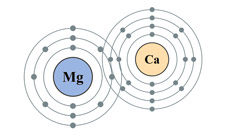
But, besides the ability to deoxidize the soil - that is, to bring its composition to the values most suitable for the growth of various plants, dolomite flour has a number of other advantages. She is:
- Improves soil structure;
- It promotes the development of microorganism colonies in it, which have a healing effect on the soil;
- If you make dolomite flour constantly, then it saturates the upper layer of the earth with easily assimilable nitrogen, phosphorus and potassium;
- Increases the return on mineral fertilizers;
- Increases the content of calcium and magnesium in the soil;
- Helps plants clear of radionuclides;
- Destroys insects, dissolving their chitinous cover. For all other creatures, dolomite is completely safe.
Determination of soil acidity
In order not to be mistaken with the amount of dolomite flour to be applied, before applying the fertilizer, it is necessary to determine the acidity of the soil. This can be done in many ways, here are the most accessible and popular ones:
Weed plants
Weeds, as well as cultivated plants, will not grow on the soil, which is not suitable for their acidity. Therefore, they are a kind of indicator that indicates the pH-factor of the soil mixture at the site. For example, dandelions, wheat grass, chamomile, clover and coltsfoot grow on slightly acidic soils. On sour - wood lice, plantain, buttercup, and on neutral ones - quinoa and nettle.
Vinegar
The use of this table sauce is one of the easiest and fastest ways to establish the rate of dolomite flour. It is used this way - a handful of soil is watered with a few drops of vinegar and looking at the reaction. If the earth begins to swell and bubble, then its pH reaction is neutral or acidic.
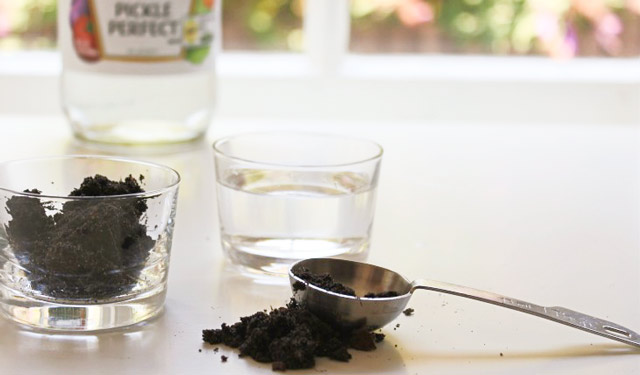
Grape juice
This natural ingredient is used as follows: they place a handful of earth in a container with juice, and if the juice changes its color and bubbles are released on the surface of the liquid, the soil has a neutral reaction.
Special devices
Of a sufficiently large number of specialized devices that are produced by both foreign and domestic manufacturers, we can recommend the following models of digital and analog portable pH meters for private use. These are non-volatile EPA-102 and EPA-103, produced in Brazil, and HI-9025 and HI-9024, digital portable devices manufactured in Germany, which provide high measurement accuracy. You can also use simple litmus paper.
Video: determination of soil acidity using litmus paper
Dolomite or lime - what to choose?
For the deoxidation of the soil, except for dolomite flour, hydrated lime (Ca (OH)), which is popularly referred to as "fluff", is very often used. It is more common for sale, and is cheaper than dolomite powder. But is it superior to consumer properties?
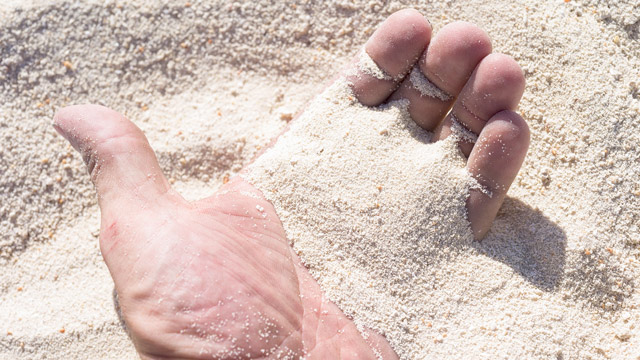
Limestone flour is considered the most powerful tool for the normalization of soil acidity. Calcium is included in its composition in the form of hydroxide (as opposed to dolomite, which contains Ca in the form of carbonate), which enhances its effect on soil acidity, increasing its ability to neutralize one and a half times.
Lime “works” faster and more actively, but this property also has negative sides. For example, for the first time after application, it prevents the absorption of the most essential substances for plants, such as phosphorus and nitrogen. Therefore, immediately after its introduction it is impossible to plant anything, the earth should “rest”. Therefore, lime powder is usually brought in the off-season, when the beds are prepared before winter, or in early spring, to ensure a good interval before planting and seedlings.
In contrast to lime, dolomite can be applied at any time, as soon as the need arises. Therefore, it has become one of the most popular fertilizers, normalizing the acidic environment of the soil.
Use of dolomite flour
Dolomite flour is always used only after it has accurately determined the acidity of the soil, otherwise it can cause significant damage to plants, up to their complete destruction. General instructions for the use of dolomite flour is as follows:
- At a soil pH factor that is less than 4.5, it is considered acidic. In such a soil make 50 kg of dolomite flour per 1 hectare.
- At a pH of 4.5-5.2, the soil is considered to be medium acid, and the rate of application of this mineral fertilizer into it is about 45 kg per 1 hundred.
- Weakly acidic soil, with a pH-reaction from 5.2 to 5.7 units, is fertilized with dolomite powder at the rate of 35-40 kg per hundred.
Also, the amount of fertilizer applied depends on the soil structure. On light soils, the use of dolomite flour is reduced by 1.5 times, and on heavy, loamy and alumina, on the contrary, they increase, by 10-15%, for the normalization of their structure.
When you are going to buy dolomite flour for fertilizing beds, garden or lawn, all these nuances must be considered when calculating. It can be purchased both in the store and ordered online. This fertilizer has a different packaging, it is sold in bags, bags and bulk. To fertilize all the land on a six-acre summer cottage, 300 kg will suffice. Given that the price of one bag weighing 50 kg, according to the prices of the leading suppliers for spring 2015, does not exceed 200 rubles, you can completely fertilize the entire area for 1200 rubles. Taking into account the fact that dolomite flour is not made more often than once every three to four years, the price of the issue is more than acceptable, because all this time the soil will yield good yields and will not sour.
Dolomite flour is also introduced into compost, both in simple and in its biologically active form - vermicompost. Worms launched into untreated humus cannot live in a compost with an unsuitable pH reaction, therefore for their comfortable existence, which causes their active reproduction, which accelerates, in turn, the processing of organic matter, it is necessary to add chopped dolomite to the pile. It will provide the necessary level of acidity.
When to make?
As mentioned above, dolomite fertilizers can be used at any time of the year, as they do not have a negative impact on the absorption of other nutrients from the soil composition. But, they are usually applied before using other fertilizers, since dolomite flour may not organically interact with all of them.
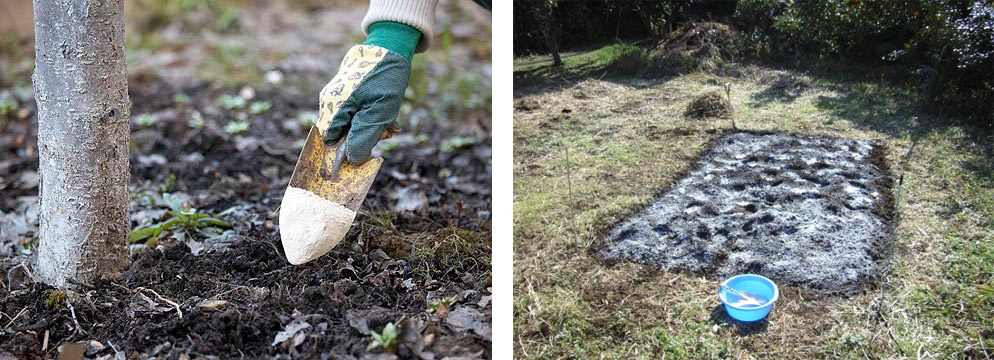
At the site intended for the cultivation of vegetables, in the spring it is scattered in advance, a couple of weeks before planting. It not only fertilizes and improves the structure of the soil, but also sanitizes it. This is very important for different cultures, including for that, which is often affected by various diseases, whose occurrence and distribution of dolomite is able to prevent. It is also particularly important for potatoes that this mineral destroys insects, dissolving their chitin shells in the joints. It helps to fight with the bear, Colorado potato beetle and other potato pests.
Dolomite flour, the use of which has a sanitizing effect on the soil, is especially relevant in the spring, as a mineral fertilizer for greenhouse plants. When tilling the soil with this mineral in the greenhouse, various fungal diseases do not spread, which has a positive effect on the harvest, and on the subsequent preservation of the fruits and berries obtained.
In the fall, this mineral dressing is used to process and feed fruit trees and shrubs. In this case, the following rates for soil application are recommended - under the tree - about 2 kg, along the rim of the trunk circle, buried in the ground, for shrubs (depending on size) - 0.5-1 kg according to the same scheme.
Liming is a term that is often used to describe soil fertilization in rocks containing calcium. This is not always true, since different substances have different effects on plants. Therefore, before embarking on soil improvement by normalizing its pH –factor, it is necessary to carefully study the instructions for using fertilizer intended for this purpose, since an excess of Ca and all its compounds is much more harmful than its deficiency.
Video: use of dolomite flour at the dacha
There are universal fertilizers that are of natural origin. With them, the harvest in the garden will always be good and environmentally friendly. One of these dressings - dolomite flour, which is made from rock. How to use dolomite flour?
What is dolomite flour?
Dolomite (limestone) flour is crushed dolomite, belonging to the group of carbonate rocks. It is produced according to GOST 14050–93, according to which the particles do not exceed 2.5 mm; fractions up to 5 mm, but not more than 7% are allowed. Limestone flour is widely used in home gardens for soil deoxidation and the control of insects with chitinous cover. For other living organisms means safe. Nevertheless, the flour contains extremely small particles, work with it should be carried out in calm weather, possibly protecting your eyes and respiratory tract.
Photo gallery: Dolomite path - from the mountain to the garden plot
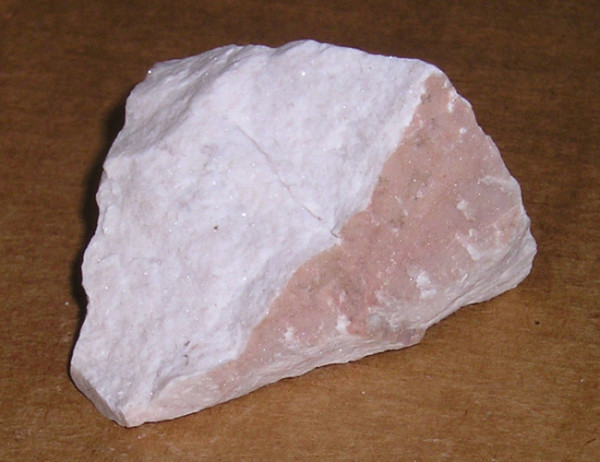
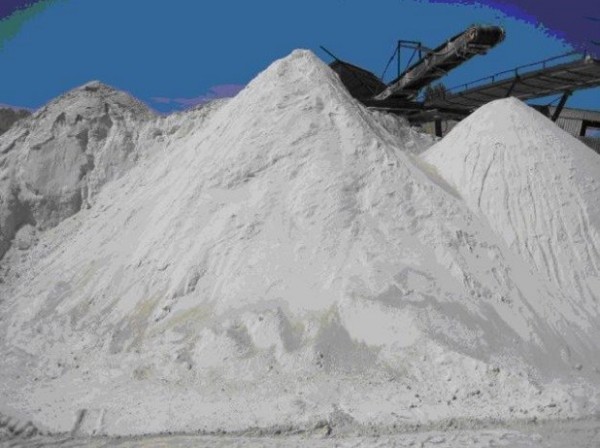
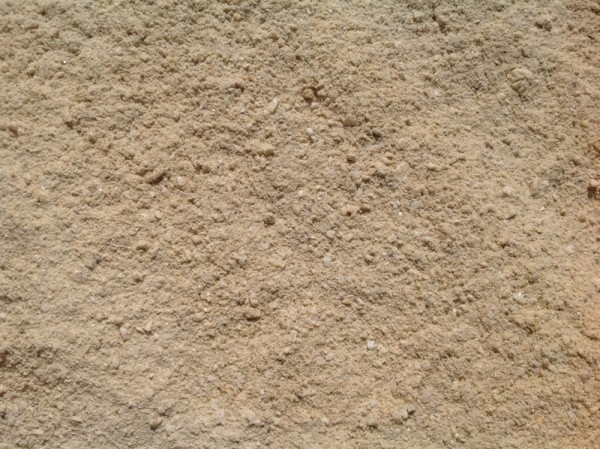
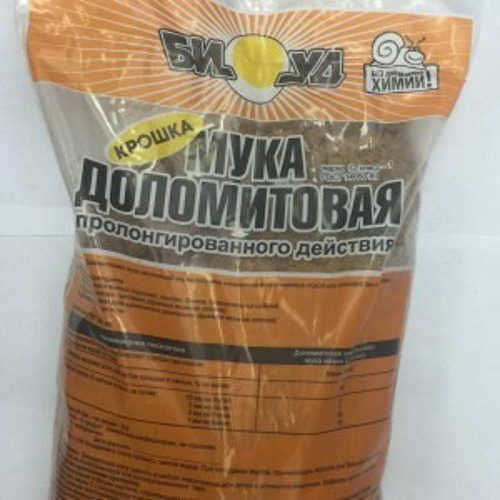
Dolomite flour sold in stores, packaged in 5 or 10 kg, has a white or gray color. When its production does not mix third-party chemical elements, as dolomite itself is useful.
The smaller the particles of dolomite flour, the higher its quality.
Table: advantages and disadvantages of dolomite flour
Table: chemical composition of dolomite flour
The percentage of moisture in dolomite flour is allowed within 1.5%.
Recommendations for the use of fertilizer depending on the type of soil
The norms for the introduction of dolomite flour depend on the chemical and biological composition of the soil at the cottage or backyard plot. One square meter requires:
- - with acidic soil (pH less than 4.5) - 600 g,
- - with medium acidic soil (pH 4.6–5) - 500 g,
- - with slightly acidic soil (pH 5.1–5.6) - 350 g
For maximum effect, limestone flour is evenly distributed throughout the site and mixed with the soil (approximately 15 cm from the top layer). You can simply scatter the tool on the ridges, in which case it will begin to act no earlier than a year later. Dolomite does not burn the leaves of plants. Its effect at the correct doses is 8 years.
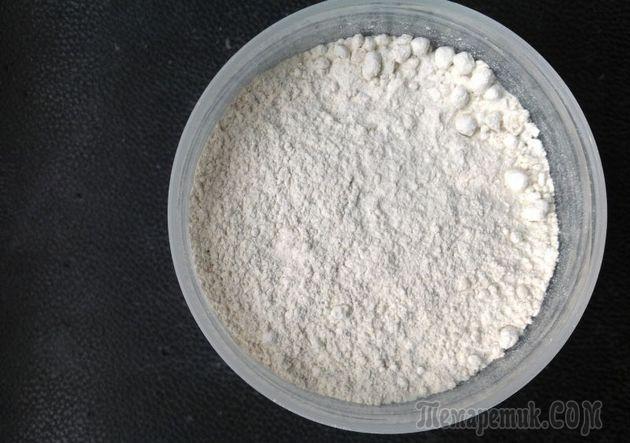
Introduction of dolomite flour to the ridges is best done in the fall
There are plants that grow on acidic soils and therefore can die from the presence of dolomite flour in the soil. By responsiveness to the introduction of such fertilizer cultures are divided into four main groups:
- They do not tolerate acidic soils, plants grow well on neutral and alkaline, they react positively to the introduction of dolomite even on slightly acidic soils. Such crops include: alfalfa, all kinds of beets and cabbage.
- Sensitive to sour soil. Plants of this group prefer neutral soils and respond positively to the introduction of limestone flour even on slightly acidic soil. These are barley, wheat, corn, soybeans, beans, peas, beans, clover, cucumbers, onions, lettuce.
- Weakly sensitive to changes in acidity. Such cultures grow well in acidic and alkaline soils. Nevertheless, they react positively to the introduction of dolomite flour in the recommended standards with acidic and weakly acidic soil. These are rye, oats, millet, buckwheat, timothy, radishes, carrots, tomatoes.
- Plants that need liming only with high acidity of the soil. Potatoes, for example, when making dolomite flour without the recommended amount of potash fertilizer can get scab, the starch content in tubers is reduced, and flax can get sick with calcium chlorosis.
Table: rules for making dolomite flour
Under the rest of the garden crops, dolomite is applied two weeks before planting in quantities that depend on the acidity of the soil. Dolomite flour in greenhouses is distributed in ridges in the amount of 200 g per 1 sq.m. Only in contrast to open ground in this case, the soil does not dig. Dolomite creates a moisture retaining film.
There are two most popular methods of liming the soil. They are named after the names of their agronomist developers:
- Mitlider's way. Instruction: for 1 kg of dolomite flour take 8 g of boric acid powder, spread it over the ridges, dig it. A week later, mineral chemical fertilizers are applied and dug again. Suitable for open ground.
- The way Makuni. Mix 2 liters of soil from the ridge, 2 liters of a special substrate for a particular crop that is being prepared for planting, 2 liters of sphagnum moss, 1 l of river sand, 4 liters of peat, then first add 30 g of dolomite flour, then the same amount of double superphosphate and two cups of crushed charcoal, mix everything thoroughly. Suitable for preparing soil mixtures for indoor flowers or for growing crops in greenhouses and greenhouses.
Table: compatibility of dolomite flour with various fertilizers
Fertilizers incompatible with limestone flour should be used no earlier than 10 days after the dolomite has been added.
Video: dolomite flour in agriculture
Gardening Tricks for Using Fertilizer
- If the soil is clayey, dolomite is applied annually. In other cases, it is used once every three years.
- It is better to apply fertilizer in the fall so that the soil rests and is saturated with all the useful elements.
- In spring or early summer, plants can be watered with a mixture of water and dolomite flour (200 g per 10 liters of water).
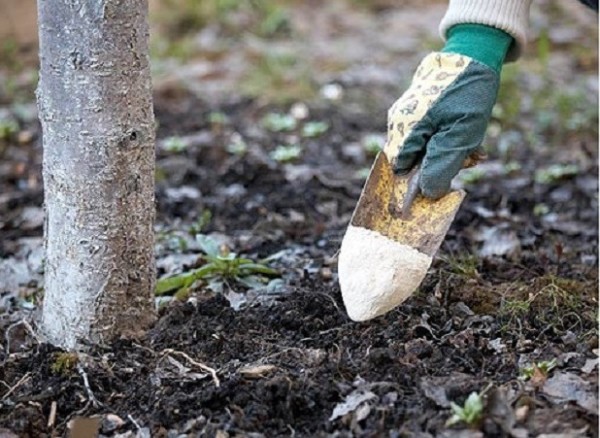
Dolomite flour under the trees is made around the perimeter of the near-barrel circle
Analogues tools for use in the garden
Dolomite flour is not the only means that can be used to deoxidize the soil, it can be replaced by other compounds.
Also successfully used to reduce the acidity of the soil. But here it is necessary to take into account the type of wood from which the ash was made, it is very difficult to calculate the required amount for deoxidation, especially in large areas. In any case, its consumption is several times higher than that of dolomite, therefore, the procedure is more expensive.
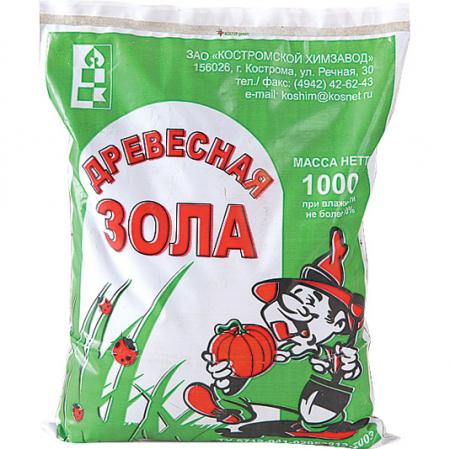
Wood ash is a costly soil deoxidizer
Lime (pushonka). It is very active, quickly leads to the neutralization of the soil, prevents the crops from sufficiently absorb phosphorus and nitrogen, therefore it is better to add lime in the fall under digging. In no case can it be poured onto the plant - the feather causes burns of the leaves. AND excessive hydrated lime causes serious damage to the roots.
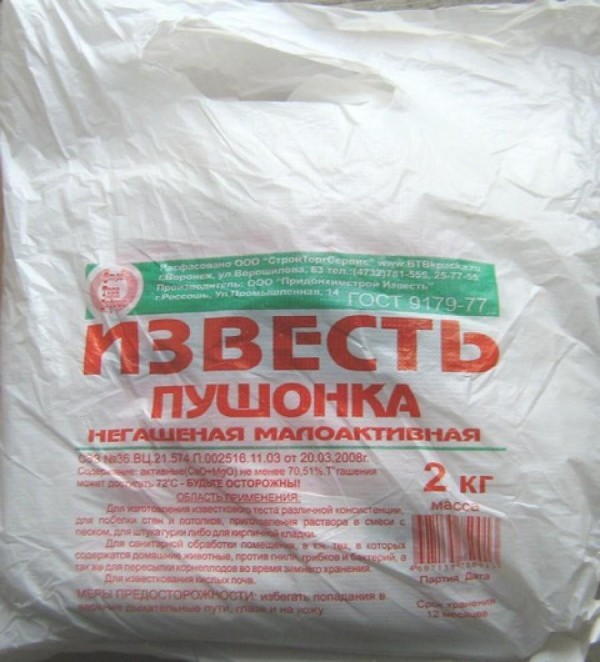
Lime causes burns on the leaves and roots of plants
Thanks to dolomite flour you can get a safe, tasty, rich harvest. This is an economical, but effective way to enrich the soil of the gardening plot with useful trace elements, without having to be afraid of damaging the plants.
In order to get a good harvest and healthy plants, it is necessary to feed them, as well as monitor the acidity of the soil. If the soil is alkaline, then problems with acidity are not terrible for it, otherwise its level should be maintained by adding lime or dolomite flour.
What properties does dolomite flour have?
The mineral substance, which is called dolomite, is brought to a powder state by crushing, so dolomite flour is obtained. This tool is inexpensive and of high quality, it is used to neutralize the acidity of the soil, and enrich it with useful elements.
Dolomite flour is rich in potassium and magnesium, these substances allow plants to fully develop. In addition to the fact that dolomite flour creates a suitable and favorable composition for plants, it has different beneficial properties.
- Dolomite flour can improve the consistency of the soil.
- This tool creates a favorable environment in the soil for the development of various microorganisms that have a beneficial effect on it.
- The constant use of dolomite flour nourishes the topsoil with nitrogen, potassium and phosphorus. And also increases the usefulness of the applied mineral fertilizers.
- The use of dolomite flour cleanses the plants from radionuclides, and they become environmentally friendly.
- The soil is saturated with a useful element, magnesium, without it the process of photosynthesis does not occur, the efficiency of organic fertilizers increases.
- Such a tool is able to destroy pests, while not harmful to plants and their fruits.
How is dolomite flour used?
Dolomite flour is actively used in horticulture, horticulture and floriculture. It can be added to the open area or in the greenhouse. This tool is used for sandy or sandy soils in which there is a lack of magnesium. Before you add dolomite to the soil, it is necessary to determine its acidity, for this is used litmus paper.
With an increased level of acidity, this tool is not used. And if this figure is below 4.5, then use dolomite flour per square meter of about 600 grams. With an average acidity of 4.5 to 5.2, add 500 grams per square meter. If the acidity of the soil exceeds the number of 5.2, then add 400 grams of dolomite flour.
It is imperative to observe the correct dosages, otherwise the structure of the soil may deteriorate. Dolomite flour can be combined with organic fertilizers.
Dolomite flour can be made from milk of lime, it is better absorbed by plants than the pure composition. For example, with this fertilizer, beets give a rich harvest, and healthy tops.
Also, with the help of dolomite flour, liming of garden plants, that is, trees and shrubs, is done every two years. This tool helps to actively fight pests.
Dolomite flour can not be used in conjunction with mineral fertilizers, superphosphate, urea or saltpeter.
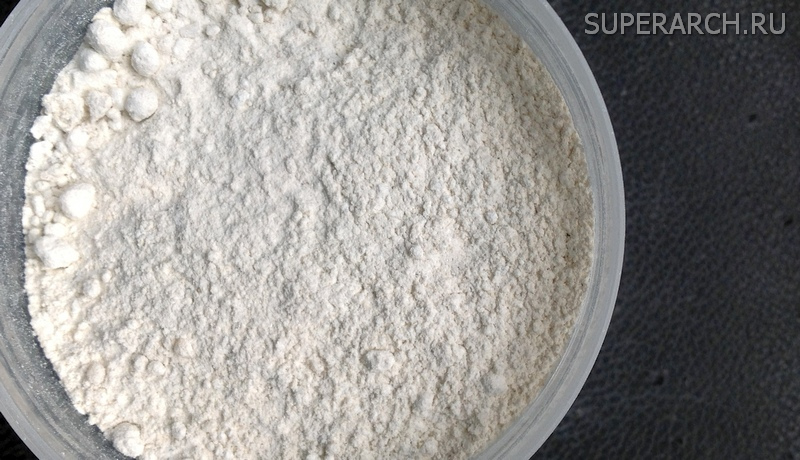
What properties does lime have?
Lime is produced by burning carbonate rock. The material is divided into three types, but the most common is slaked lime, which is obtained by adding water. So that the tool does not lose its beneficial properties, when it is extinguished, cold water is used.
Lime is rich in calcium, it is this element that contributes to the development and activity of various plants. Due to this fertilizer, the plants become stronger, and are not exposed to various diseases that occur due to lack of calcium.
After carrying out liming, nodule bacteria actively proliferate in the soil, which help to keep nitrogen in the ground after loosening. As a result, nitrogen is actively supplied to the roots, and the plant is fully developed, obtaining beneficial elements. In plant tissue improves the movement of carbohydrates. Thanks to calcium, the elements dissolve well in the aquatic environment. When lime is added to a compost pit, beneficial bacteria are created that are able to secrete and mineralize nitrogen from organic matter. Calcium contributes to the rapid decomposition of organic elements, and the creation of humus, supports neutral acidity in the soil.
Lime prevents the release of toxic substances from heavy metals, makes the soil structure ideal, it takes the form of lumps, rather than flowability.
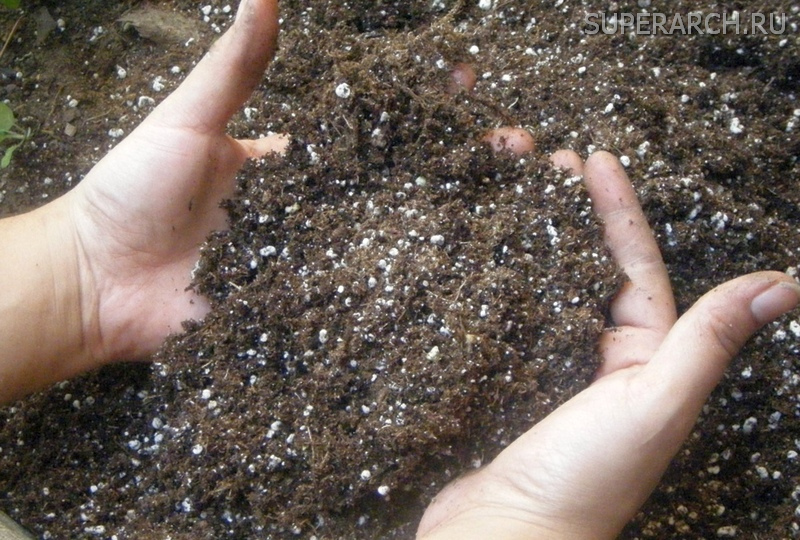
How is lime used?
Lime is used to normalize the acidity index of the soil; liming is performed once every five years. With the active exploitation of the soil, such work is carried out once in three years. At first, it is necessary to pay attention to the soil itself, if horsetail, wormwood or moss are actively spreading on it, then the earth needs lime treatment.
The main work on liming should be performed in the autumn period, and in the spring it is possible to make only partial processing, adding a small amount of money. In the spring, you need to observe the gap before planting seedlings or seeds for about seven days.
When using only mineral fertilizers, the processes of liming the soil should be intensified. And the use of natural fertilizers contributes to the self-maintenance of a normal indicator of acidity, so the use of lime will be superfluous.
Also bleached with tree trunks, it helps prevent pests. The tool is effective and inexpensive, it is done in the spring and autumn.
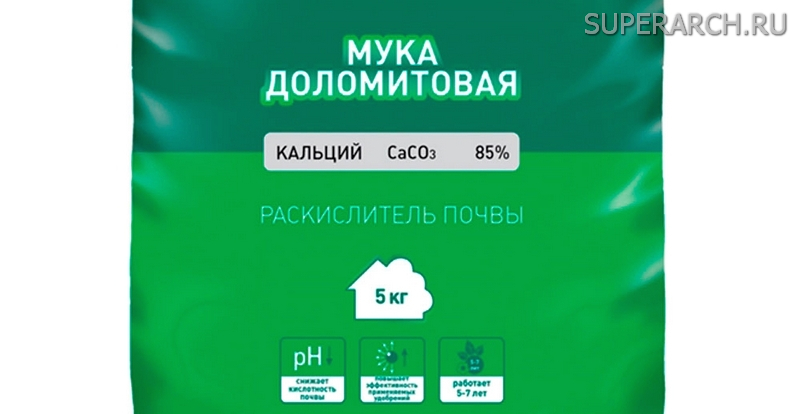
Is dolomite flour or lime better?
Compared with lime, dolomite flour contains eight percent more calcium. Thanks to this element, the root system of plants is well formed and developed, and the soil structure is improved. Also in the dolomite contains 40 percent magnesium, it contributes to the passage of photosynthesis in plants, and in lime this element is absent.
With a shortage of magnesium in the soil, shoots develop poorly, the leaves can wither and fall off, and the plant itself can be subjected to various diseases that are hard to fight.
To normalize the acidity of lime used slaked form, that is, the fluff, its cost is lower than dolomite flour. The use of lime is the strongest way to restore soil acidity. Calcium, which is a part of it, is in the form of hydroxide, and in dolomite it is used as carbonate. That is, lime has an active effect on soil acidity than dolomite and a half.
Lime helps restore soil acidity more quickly, but it also has its downsides. Immediately after its introduction, it is quite difficult for a plant to assimilate such necessary elements as nitrogen and phosphorus. Therefore, lime is applied in advance before planting so that the soil can rest. Lime is usually used in the autumn period so that the soil is free throughout the winter.
Dolomite differs from lime in that it can be used at any time, so it is actively used to normalize the acidity of the soil.
When is it necessary to use lime and dolomite flour?
It is possible to fertilize a site with dolomite flour in any season, this means does not have a negative effect on plants, and allows them to assimilate other nutrients from the soil favorably. But this tool must be applied before other fertilizers, as it is not combined with all types of dressings.
If fertilizer will be produced at the site where vegetables are planted, in the spring period, flour should be spread all over the surface two weeks before planting. Dolomite flour can improve soil structure, fertilize it, and prevent the development of diseases. With this tool you can actively fight pests that affect potatoes and other crops, for example, a bear or the Colorado potato beetle. In the spring, this fertilizer is especially important, as it acts as a mineral dressing for plants, and kills fungal diseases. In the autumn, dolomite flour can be processed and fed to the plants in the garden, that is, trees and shrubs. For one tree, you will need 2 kilograms of dolomite flour, and for a bush - up to 1 kilogram, it will be buried in the soil under the plant.
Lime is also used to normalize the acidity of the soil. But this should be done only on the soil where there is increased acidity. If the soil is not sour, then do not make liming. I process the soil with lime when preparing the planned plot or garden. If strawberries are planted on the plot, then the liming is made two years before the work. You can also make lime after the plants are strong, that is, two months after planting. Garden liming can be done in any season. Means is brought in the autumn and spring period during a soil digging.
Lime must be thoroughly mixed with the ground, so it is used in a powdered state. The use of quicklime is forbidden, as it comes in lumps, and the soil can be over-saturated. It can be extinguished with the help of water per 100 kilograms of material 4 buckets of liquid, only after that lime is used as fertilizer.
Lime is poured evenly over the entire earth, with proper dosage. If the soil is loamy and clayey in nature, then up to 14 kilograms of such a product is applied for 10 square meters, this fertilizer lasts for 15 years. And for soils of sandy and sandy nature, add up to 1.5 pounds on the same area, this is enough for two years. If you do not comply with or exceed the dosage, the soil may overload and become harmful to plants.
How to determine the acidity of the soil?
Before you apply fertilizer in the form of dolomite flour or lime, it is necessary to determine the acidity of the soil on the site, so as not to oversupply the earth. This is done in several ways, using weeds, vinegar, grape juice or special tools.
Weed grass will not grow on land that does not meet normal acidity. They can serve as a specific indicator of soil acidity. On a plot with weak acidity, chamomile, dandelions, wheat grass and clover are actively growing. Plantain, buttercup or wood louse grows well on too acidic soil, and nettle or quinoa on the ground with a neutral indicator.
Using vinegar, you can easily, quickly and easily determine the acidity of the soil. A few drops of vinegar are applied on the ground, and if it swells up and bubbles appear, the soil is neutral or acidic.
Also, the acidity can be checked with the help of grape juice, the earth is put into it, and if it changes its color and bubbles appear on the surface, then the soil is neutral.
The most reliable determination of soil acidity is the use of special devices, such as pH meter or litmus paper. This allows you to accurately determine the acidity of the soil.
The difference in the use of dolomite flour from lime
Dolomite flour is not able to harm plants and burn their leaves, so it can be used not only for vegetable plants, but also to fertilize lawns. It can be used in any season. And it is better to bring lime in the autumn period, so that the earth will rest, since after such fertilizer, it is necessary to wait for planting time.
Dolomite flour and lime cannot be combined with mineral fertilizers, such as nitrate, superphosphate or urea. Lime is used very rarely to reduce or normalize the acidity, since it has a more severe effect; this can lead to soil oversaturation and plant burns.
Liming of soil increases the efficiency of organic fertilizer, it begins to decompose faster and feed the plants. Lime can be combined with manure for fertilizer, while reducing the amount of organic dressing. But before using such fertilizers, it is necessary to determine the acidity of the soil on the site.
On the existence of limestone flour (dolomite flour) knows almost every plant breeder. The phrase dolomite flour is constantly on hearing at all summer residents and gardeners. However, despite the wide popularity of this substance, few people know how to properly and for what purpose it should be used. Let's look at what dolomite flour is made of and what it is.
Dolomite (limestone) flour: general characteristics
Many novice breeders are concerned about the question of what dolomite flour is and when it should be added to achieve maximum results. Dolomite flour has been used in horticulture and crop production for a very long time. It is a coarse grinding substance obtained by crushing and grinding of carbonate minerals, most of which are dolomites. Dolomite flour has a simple composition, the chemical formula of dolomite is CaMg (CO2). Its main active ingredient is calcium.
The main cause of soil acidification is the displacement of calcium from the soil by hydrogen ions. To improve the quality of the soil and stabilize the pH, the balance of hydrogen and calcium ions is recommended to be maintained artificially with the help of dolomite flour or other means.
Properties of dolomite flour: how useful to use in the garden
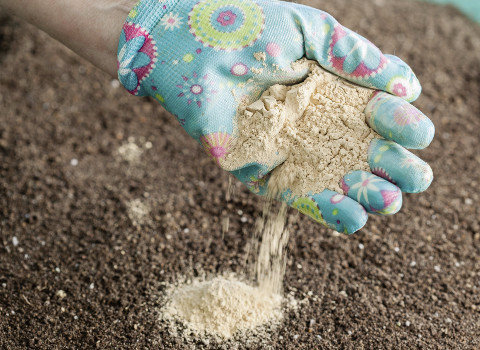 Dolomite flour is most often used in crop production. Due to the fact that it contains a large amount of calcium and magnesium, dolomitic limestone flour is used to improve the composition of the soil and its deoxidation.
Dolomite flour is most often used in crop production. Due to the fact that it contains a large amount of calcium and magnesium, dolomitic limestone flour is used to improve the composition of the soil and its deoxidation.
However, dolomite flour is used not only to bring the soil indicators to the optimum parameters for growing plants, its introduction provides the plant grower with a number of important advantages:
- soil structure improvement;
- saturation of the top layers of soil with easily absorbed forms of nitrogen, potassium and phosphorus;
- promoting the development of beneficial soil bacteria;
- the increase in the soil content of magnesium and calcium;
- the acceleration of the removal of radionuclides from plants;
- improving the absorption of nutrients by plants;
- activation of photosynthesis.
Dolomite flour: how to apply lime fertilizer
To get the maximum result from dolomite flour, you need to know how to use it properly. Before using dolomite flour in spring or autumn, you must first measure the acidity of the soil, as the amount of fertilizer depends on this parameter.
Important! When using dolomite flour for soil deoxidation, try to strictly observe the dosage, since its excessive application can significantly change the soil parameters and make it unsuitable for growing plants.
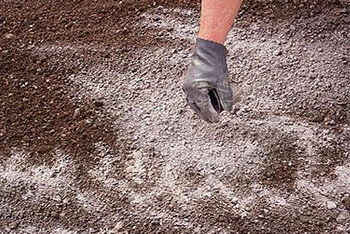 Introduction of dolomite flour will allow you to quickly optimize the main soil biological processes, which has a positive effect on plant development.
Introduction of dolomite flour will allow you to quickly optimize the main soil biological processes, which has a positive effect on plant development.
Dolomite flour is actually safe, but in order to achieve maximum results from the application, you should carefully read the instructions for its use.
Introduction of dolomite flour is best done in the fall, but in case of emergency it can also be used in spring and summer. Did you know? Dolomite flour can be used to spray plants as an effective means to combat insect pests, as it has a destructive effect on their chitinous shell. When making the drug should be as evenly as possible to distribute it over the entire surface of the site to a depth of no more than 15 centimeters. If you can not make the drug in the ground, then you can scatter it on the surface of the beds. However, in this case, the effect of its use will become noticeable no earlier than after 12 months.
Dolomite flour is an absolutely safe substance for humans, birds and animals, and therefore even if it is scattered over a pasture, it will not cause any harm to the health of the herd. Important! Remember: dolomite flour is not recommended to bring into the soil along with ammonium nitrate, urea and superphosphates.
Terms of making dolomite flour
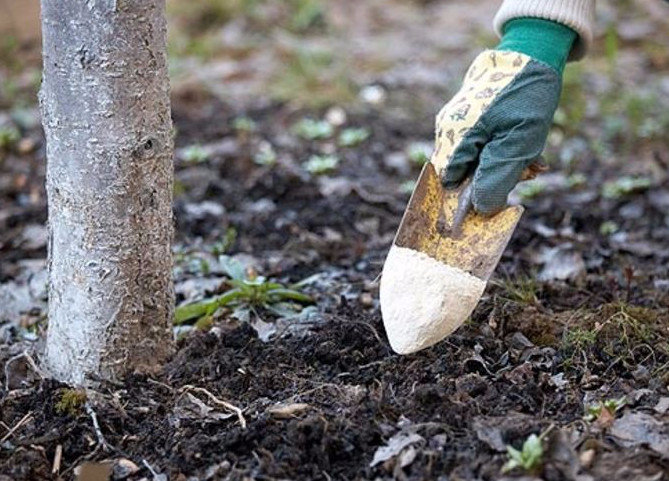 Limestone flour is used every three or four years, the multiplicity of application depends on the pH of the soil. For example, to improve the characteristics of heavy clay soils dolomite flour should be made annually.
Limestone flour is used every three or four years, the multiplicity of application depends on the pH of the soil. For example, to improve the characteristics of heavy clay soils dolomite flour should be made annually.
If dolomite flour is used to improve the quality of the soil near the trees, 1 to 2 kilograms of the product is harvested every two years after each harvest. If you are top dressing bushes, then lime powder will need to pour under each plant from 0.5 to 1 kilogram.
Did you know? For plants that prefer acidic soil, such as sorrel or gooseberry, it is not recommended to make dolomite flour, as this will affect the pace of their development and yield. Dolomite flour should also be made before planting greenhouse or indoor plants, after adding it is thoroughly mixed with the substrate. Its introduction has a positive effect on the development of orchids, violets and hyacinths. The systematic introduction of dolomite flour into the soil allows increasing the yield of garden crops from 4 to 12 percent.
How to apply dolomite flour: consumption rates
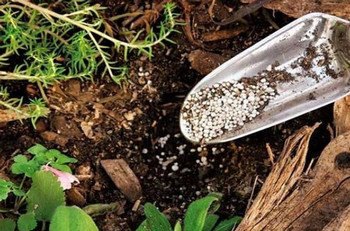 Dolomite flour can be used at any time of the year, it is safe, and besides, it does not interfere with the absorption of other nutrients by plants. However, most often the introduction of funds is carried out in the spring for a few weeks before the beginning of the planting of plants in the ground. When using dolomite flour, it is not recommended to apply it simultaneously with other fertilizers, as it does not interact organically with all of their types.
Dolomite flour can be used at any time of the year, it is safe, and besides, it does not interfere with the absorption of other nutrients by plants. However, most often the introduction of funds is carried out in the spring for a few weeks before the beginning of the planting of plants in the ground. When using dolomite flour, it is not recommended to apply it simultaneously with other fertilizers, as it does not interact organically with all of their types.
And now let's consider how to properly deoxidize the soil with dolomite flour:
class = "table-bordered"\u003eOther soil deoxidizers: how else can you lick the soil
After harvesting, gardeners put a lot of effort to get good results the next year. Perennial plants require special attention, which delight the plant growers with their fruits for years. A good fertile site with an optimal pH level is a rarity, and therefore timely fertilization and acidification are the key to getting excellent yields every year.
Did you know? Acidic soils are characterized by a high content of salts of heavy metals such as aluminum or manganese, which reduce the rate of development of most garden crops. With high acidity, the soils are deoxidized using dolomite flour, fluff lime or wood ash.
Pushon lime is a white powder easily dissolving in water. When mixed with water, the breeder gets hydrated lime. This substance is very often used in the production of lime fertilizers and is one of the important components in the manufacture of bleach.
 Lime-pushonka is used in cases when it is necessary to get rid of garden and garden diseases and pests. And now let's consider what is better - dolomite flour or lime.
Lime-pushonka is used in cases when it is necessary to get rid of garden and garden diseases and pests. And now let's consider what is better - dolomite flour or lime.
Lime-pushonka for soil deoxidation will require virtually the same amount as dolomite flour. But the main disadvantage of the lime-fluff is that it can be used only once in 6 or 8 years, as it provokes the occurrence of specific processes in the ground, which can negatively affect its quality. And besides, lime does not have such a positive effect on the soil as dolomite flour.
Many plant growers use wood ash not only as an excellent fertilizer, but also as an excellent soil deoxidizer. It loosens the soil and improves its moisture and breathability. The use of wood ash is advisable on all types of acidic soil:
- sod-podzolic;
- podzolic;
- brown forest;
- light gray forest;
- swamp-podzolic;
- peat bog.
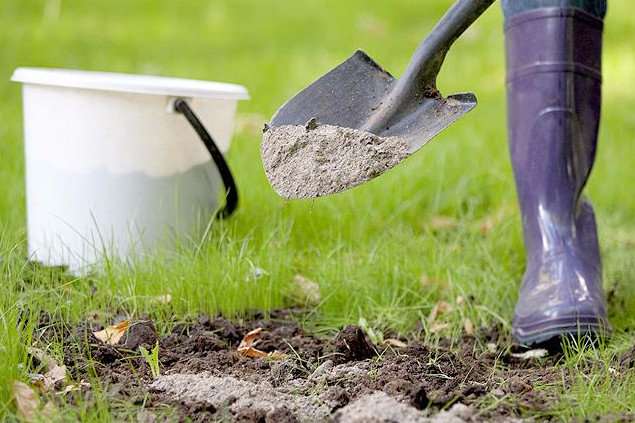 The amount of wood ash that needs to be added depends on the acidity level of the soil. On average, it ranges from 0.7 to 1.5 kilograms per 1 m². It is recommended to deposit ash into the soil during spring digging. Sometimes growers practice the introduction of ash in the wells or planting pits, but this should be done very carefully so as not to burn the roots of the plant.
The amount of wood ash that needs to be added depends on the acidity level of the soil. On average, it ranges from 0.7 to 1.5 kilograms per 1 m². It is recommended to deposit ash into the soil during spring digging. Sometimes growers practice the introduction of ash in the wells or planting pits, but this should be done very carefully so as not to burn the roots of the plant. The main drawback of ash is that it will have to be added every year, unlike dolomite flour and lime-fluff. But on the other hand, it contains much more nutrients, which allows it to be used as an effective fertilizer.
The advantages of using dolomite flour in the garden
Growers note that dolomite flour is an excellent fertilizer, significantly increasing the yield of horticultural crops.
The use of dolomite flour contributes to the reduction of weeds on the site, reduces the likelihood of epidemics of pests and fungal infections. In addition, it is a natural remedy that does not contribute to the accumulation of herbicides and pesticides in plants, which allows for an environmentally friendly crop. Dolomite flour as a fertilizer should be used in the garden in the spring, it increases the plant's own immunity, which allows them to successfully withstand most plant infections and subsequently improves their winter resistance.
Dolomite flour is an effective and absolutely safe remedy that costs a penny, but brings benefits to a million.
Was this article helpful?
Well no
Dolomite flour is a finely ground rock used as a fertilizer. Raw materials for making flour in large quantities contains calcium and magnesium. These minerals are needed to improve the physicochemical properties of the soil. Calcium ions can artificially reduce the acidity of the soil. Dolomite formula: CaMg (CO2).
Dolomite is a rock formation.
Soils with increased acidity are not suitable for the cultivation of healthy crops. Improve the properties of the soil, change its composition, help natural minerals. The composition of dolomite flour includes calcium and magnesium. Calcium has a positive effect on the root system of plants, reduces the acidity of the substrate. Magnesium takes part in photosynthesis.
Regular use of dolomite flour can increase yields, increase the growth of healthy crops. When excessive acidity neutralizes the effect of other mineral fertilizers. After making dolomitic flour, the digestibility of nutrients by plants improves.
We measure soil acidity
In order not to cause harm, you need to know how to use lime fertilizer. Before making it necessary to check the acidity of the substrate. According to the results of testing, it will become clear in what quantity dolomite flour is to be made, and whether it is worth it. The easiest way to independently test the acidity of the soil - testing using litmus paper.
There are ways to approximately determine the acidity. Their use is advisable if there is no litmus paper at hand. The simplest is to pour vinegar over the ground. To do this, take a small amount of soil from the bed, place in a glass. Pour a little table vinegar on top. If foam appears on the surface of the substrate, then the earth has a very low acidity. If the fluid is completely absorbed, then the earth is very acidic.
To determine the acidity in the garden can be, looking at the growing weeds. Wood lice and plantain live well on acidic soils. Neutral soils are attractive for nettles and quinoa. Chamomile and dandelion grow well on alkaline substrate. If some of these plants dominate the site, then it can be understood if the land needs a dolomite.
Determine the amount of fertilizer
Determining the acidity of the soil on the site, you can make flour. For increased acidity (pH less than 4.5) you need 500-600 grams per 1 sq.m. With an average value (pH 4.5-5.2), 450-500 grams per 1 square meter is enough. If the soil has a weak acidity (pH 5.2-5.6), then the amount of dolomite flour should not exceed 350-450 g per 1 sq.m.
When the acidity is neutral (pH 5.5-7.5), it is sometimes necessary to add mineral flour. It all depends on the crops that are planned to be planted on this site. It is impossible to increase the amount by 1 square meter too much, since the acidity can be greatly changed, and this will adversely affect the quality of the soil.
On the original packaging with fertilizers contains instructions for use. It is recommended to introduce flour that changes acidity into the soil, no more than once every three years. This is best done in the fall, since the main components of the flour enter into a chemical reaction with the elements that make up the soil. By the spring, all chemical reactions cease, and the earth acquires the necessary qualities.
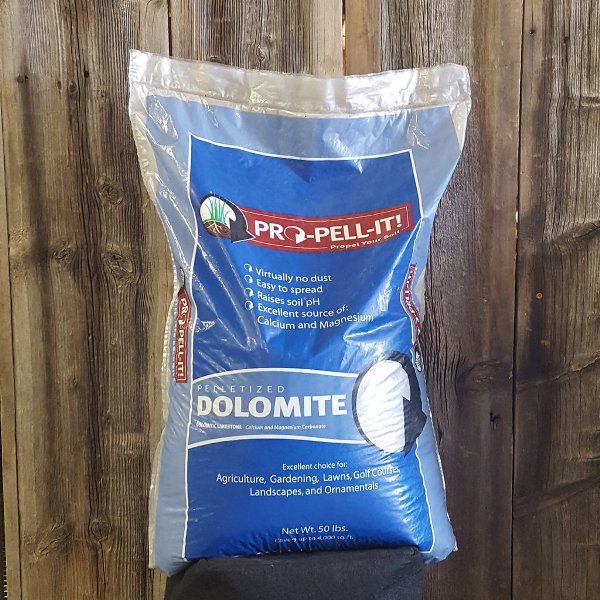
Factory packaging with crushed dolomite.
results
After applying dolomite flour, the physical and chemical properties of the soil are noticeably improved. Dolomite composition enriches the sandy soil with magnesium. As a result, the absorption of nutrients from the soil by plants is improved. The quality of the grown products increases, its safety improves.
The use of ground dolomite in the garden helps to neutralize slugs that can spoil the majority of useful crops. The tool is not toxic, and the desired effect is achieved due to the structure of the flour. The smallest particles of calcium destroy the chitin integuments of pests, as a result of which insects die.
It is useful to make dolomite flour under the garden trees and shrubs. For trees with stone fruits, the amount of fertilizer should be 1-2 kg. Milled dolomite must be spread around the barrel. To fertilize trees it is not necessary to wait for the pre-winter period. Calcium enrichment can be performed immediately after harvest.
Black currants and raspberries can be fertilized at the end of summer or in autumn 1 time in 2 years. Under each bush you need to make 0.5-1 kg of mineral. The exact amount depends on the size of the plant and the frequency of fertilization.
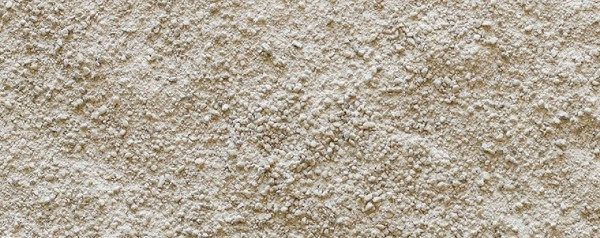
Ready to make flour in the ground.
Benefits
Limestone, charcoal and some other substances resemble dolomite flour in their properties. However, ground rock has advantages over other fertilizers. Its use contributes to the most rapid and accurate soil deoxidation. This result is difficult to achieve when using wood ash, since the amount of calcium in this substance varies and depends on many factors. Lime pushonka well deadens the substrate, but its incorrect dosage can cause plant burns.
About what dolomite flour, every gardener who wants to increase his harvest knows. This fertilizer in stores is low price, so anyone can use ground dolomite for use on their own plot.
